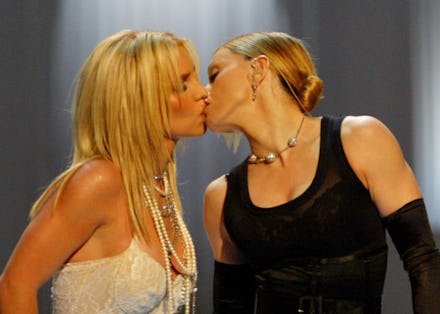"Going Both Ways" Doesn’t Go Both Ways For Men vs. Women

Most people who went to liberal arts colleges are familiar with the cultural archetype of the Lesbian Until Graduation (LUG).
The story usually goes like this: Some cute girl from Nowhere, Ohio enters freshman year wearing headbands and intent on majoring in English. She spends her weekends on the phone with her high school boyfriend, who has some nondescript boy name like Brian or Phil. Then, before you know it, she's taken a women's studies class, discovered Ani DiFranco and pixie cuts, and is dating some punk chick in a riot girl band.
You see the LUG in pop culture all the time, from Friends to the L Word to college comedies a la American Pie.
But never fear. The LUG is merely involved in some kind of brief rebellion (against her parents/society/whatever). After her four years of girl-on-girl fun, she will re-enter the straight world before eventually marrying a guy.
We're obsessed with the LUG's sexual expression (though we don't take it seriously) and with female sexual "experimentation" in general, but you'd be hard pressed to find a male cultural equivalent of the LUG.
Why? Aren't we 20-somethings supposed to be breaking down all these kinds of norms?
Pop culture's depiction of lesbian sexuality as constructed for and by men may be one reason it's generally more acceptable for women to embrace a fluid sexuality than it is for men. A new British study found that more women than ever are having sexual experiences with other women, while the numbers of same-sex experiences for men remain constant. (One possible explanation for the numbers is that women inherently are more sexually fluid than men, but they are also clearly a result of socialization across genders.)
Alyssa Ranker, 26, dates both men and women. She attended Smith College, a progressive women's college in Massachusetts with a large queer community where "sexual fluidity" can be called the norm. She believes that one reason we accept "experimentation" in women is that a woman's femininity is not necessary challenged by being gay.
"As long as she's femme and pretty and sexy, she's still hetero-hot, still girly. But a typical American man's masculinity is placed deeply in question by his possible bisexuality, or even a hint of a gentle, feminine nature," said Alyssa.
"I think about how many times I heard boys in the high school where I went call each other 'fag' versus the number of times I heard the girls call each other 'dyke.' (Spoiler alert: never!) I think about the number of girls versus boys who were out in the same high school (way more girls than boys). It all seems related. Male gayness is so illegitimate in our society; gay men are seen, at worst, as aggressive and scary sexual predators, perverts, AIDS-carriers. None of these stigmas are so consistently attached to lesbians."
Not only do gay men face these stigmas, but being sexually fluid at all is even less acceptable for men, as we saw when British diver Tom Daley came out recently as bisexual.
Daley is currently dating a man, but insists that he is still attracted to women. Though many younger fans embraced Daley upon his announcement, some did not. As Ann Friedman wrote at NY Mag,"[Many] assumed Daley was gay but unable to fully admit it, or unwilling to relinquish the privileges of being straight. He was called greedy and accused of trying to have it all."
Sexually fluid men are generally greeted with such skepticism. The assumption often is that the man in question is just not being fully "open" about his true sexuality, as a 2011 New York Times article titled, "No Surprise For Bisexual Men: Report Indicates They Exist" shows pretty clearly. Though bisexuality is often dismissed as a sexual orientation as a whole — a recent study found that 15% percent of people don't believe in bisexuality at all — the effects of such beliefs are even starker for men.
Even in our age of enlightenment, we still seem to believe that women can be attracted to multiple gender and sexual identities, but men just can't.
This trend is indicative of our larger issues about what sexual identity really is. What's missing from a lot of the cultural conversations around bisexuality, experimentation, and sexual "authenticity" for young people is the fact that people continue to figure out their sexual identities as they grow up, particularly in college. Just as you might discover a kink you never knew you had or a sex position you really like, you can of course discover that you're attracted to different people (or kinds of people) more than you initially thought.
Rigid labels don't help anyone, leaving us with little room for exploration without judgment or dismissal. Thankfully, growing numbers of young people are increasingly subverting them or leaving them behind.
Maybe all we need now is a pop culture bromance with just a hint more romance.